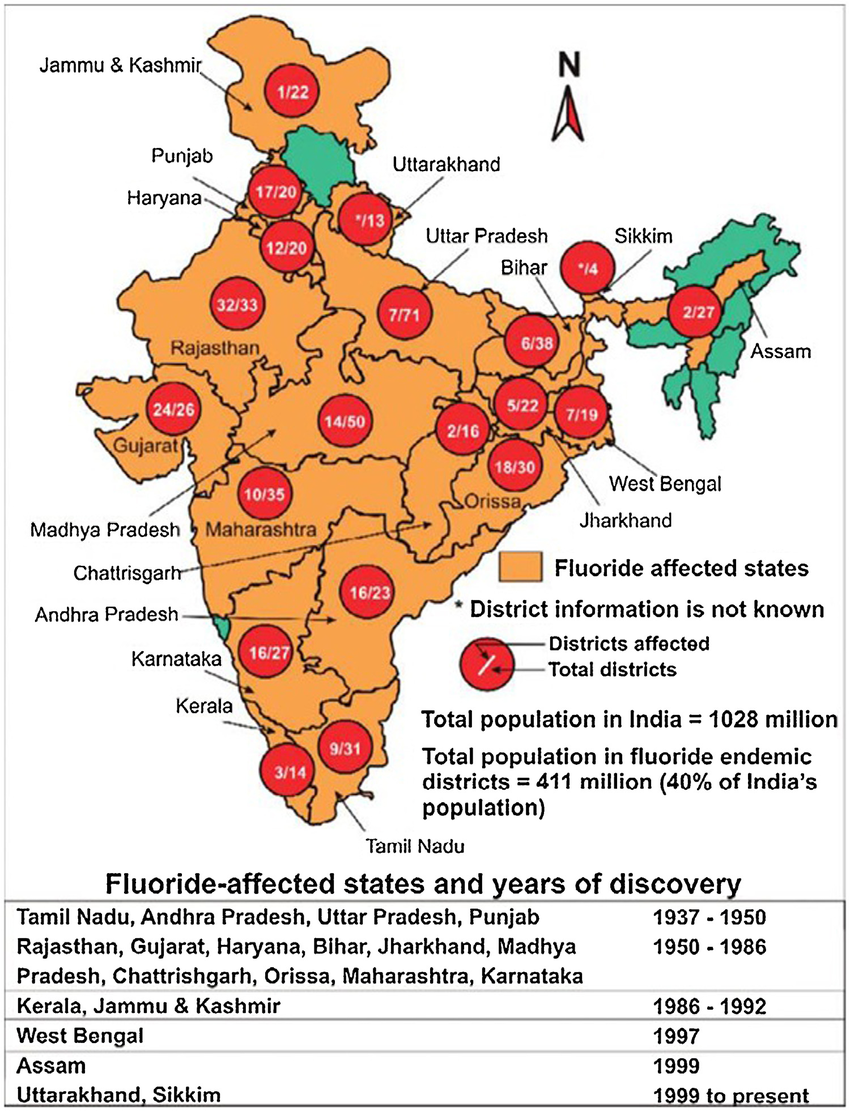Fluoride & Iron Removal technology of CMERI | 09 Oct 2020
Why in News
The Central Mechanical Engineering Research Institute (CMERI) has transferred its High Flow Rate Fluoride & Iron Removal technology to Capricans Aqua Private Limited, West Bengal.
Key Points
- Technology:
- It is a Community Level Water Purification System which has a Flow-Rate capacity of 10,000 Ltr/hr.
- It uses commonly available raw materials such as sand, gravel and adsorbent materials.
- It comprises a three-stage purification process that purifies water within permissible limits (1.5 parts per million (ppm) & 0.3 parts per million for Fluoride and Iron respectively).
- The technology uses a combination of Oxidation, gravity settling (settling down of heavier impurities under gravity) and Chemisorption process in an Affordable Package.
- Chemisorption is a kind of adsorption which involves a chemical reaction between the surface and the adsorbate. New chemical bonds are generated at the adsorbent surface.
- The integrated backwashing technology will help in improving the shelf-life of the filtration media in a resource rationalized manner.
- Backwashing refers to pumping water backwards through the filter media, for the preventive maintenance so that the filter media can be reused.
- Significance:
- The number of Fluoride affected individuals are continuously increasing in a contaminated habitat in the last 50 years.
- This has been happening in consonance with the disproportional depletion of the Water Table, which has led to the multiplication of the level of concentration of Fluoride in the particular region.
- The deployment of this Community Level system at affected places can help to turn the tide against the menace of Iron and Fluorosis across the Nation.
- Cost-Effective solution for serving the most vulnerable sections of the Nation.
- Besides, the technology is also a major thrust towards the Atmanirbhar Bharat campaign.
- The proliferation of this technology will also help in catalyzing Employment Generation opportunities.
- The number of Fluoride affected individuals are continuously increasing in a contaminated habitat in the last 50 years.
- Iron in water: Iron is the most common contaminant of drinking water, followed by salinity, arsenic, fluoride, and heavy metal.
- Rajasthan had the highest number of rural habitations affected by contamination overall, at 16,833 in 2019.
- Combined arsenic and iron pollution affect West Bengal and Assam the worst.
- Reason: Corrosion of pipes is a common reason why iron is found in drinking water.
- Impacts: As little as 0.3 mg/L concentration of iron can make the water appear brown.
- The overload of iron may cause severe health problems such as liver cancer, diabetes, cirrhosis of liver, diseases related to heart and central nervous system, infertility etc.
- Rajasthan had the highest number of rural habitations affected by contamination overall, at 16,833 in 2019.
- Fluoride in water:

- High levels of Fluoride were reported in 230 districts of 20 States of India (2016-17).
- Reasons: Naturally occurring fluoride in water along with the result of industrial processes.
- Owing to inaccessibility to Affordable Fluoride Removal Solutions the Fluorosis affected statistics has also witnessed an upward trajectory.
- Impact: There are two main types of fluorosis, namely dental and skeletal fluorosis.
- Dental fluorosis is caused by continuous exposure to high concentrations of fluoride during tooth development.
- Skeletal fluorosis is developed by the disturbance of calcium metabolism in the formation of bones of the body.
- It results in the softening and weakening of bones resulting in deformities leading to crippling.
- The National Programme for Prevention and Control of Fluorosis:
- NPPCF is a health initiative launched in the 11th Five Year Plan, initiated in 2008-09.
- Objectives:
- To collect, assess and use the baseline survey data of fluorosis of the Ministry of Jal Shakti.
- Comprehensive management of fluorosis in the selected areas.
- Capacity building for prevention, diagnosis and management of fluorosis cases.
Central Mechanical Engineering Research Institute
- CMERI is a public engineering research and development institution in Durgapur, West Bengal.
- It is a constituent laboratory of the Council of Scientific and Industrial Research.
Council of Scientific and Industrial Research
- CSIR is the largest research and development (R&D) organisation in India. CSIR has a pan-India presence and has a dynamic network of 38 national laboratories, 39 outreach centres, 3 Innovation Complexes and 5 units.
- Established: September 1942
- Located: New Delhi
- CSIR is funded by the Ministry of Science and Technology and it operates as an autonomous body through the Societies Registration Act, 1860.
- CSIR covers a wide spectrum of streams and provides significant technological intervention in many areas with regard to societal efforts which include the environment, health, drinking water, food, housing, energy, farm and non-farm sectors.
